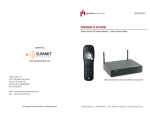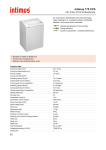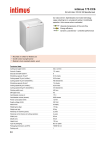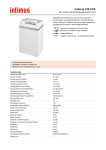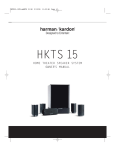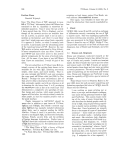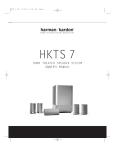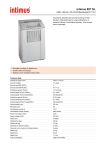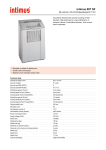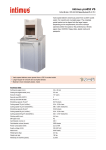Download Aperion Audio Intimus Series User's Manual
Transcript
Owner’s Manual Intimus Series Loudspeakers 522D-LR Bookshelf Speakers 522D-C Center Channel 522D-VAC Vertical Array Center Channel 522D-SS Dipole/Bipole Surround Speakers 522D-PT Power Towers S8-APR Subwoofer S-10 Subwoofer S-12 Subwoofer © 2004 Aperion Audio, all rights reserved. Revision 5008 July 2004 Aperion Audio Owner’s Manual Table Of Contents Thank You From Aperion Audio .......................................................................1 The Joy of Buying Direct ................................................................................1 DiAural® Crossover Technology .......................................................................1 What You’ll Need For Installation ....................................................................2 Choosing The Right Speaker Wires ..................................................................2 Placement: ................................................................................................3-8 - Stereo Placement & Installation...................................................................3 - Multichannel Music & Home Theater Placement ..........................................4 - Speaker Placement For Surround Sound.......................................................5 - Mounting Your Bookshelf Speakers ............................................................5 - Speaker Placement Diagrams For Home Theater & Multichannel Music ...........6 - Dipole/Bipole Placement & Operation ...........................................................7 - Wall Mounting Your Dipole/Bipole Speakers ................................................8 Connections:............................................................................................9-11 - Home Theater Connection Diagram ..............................................................9 - Making The Connection..............................................................................10 - Connecting Your Subwoofer ........................................................................11 Subwoofer Setup ....................................................................................12-13 - S8-APR Setup .........................................................................................12 - S-10 or S-12 Setup..................................................................................13 Power Tower Setup ......................................................................................14 Dialing In Your System............................................................................15-16 - Speaker Setup ..........................................................................................15 - Speaker Distance ......................................................................................15 - Subwoofer Setup .......................................................................................15 - Speaker Level Calibration ...........................................................................15 - Speaker Break-In.......................................................................................16 - Troubleshooting.........................................................................................16 Specifications ........................................................................................16-18 Warranty .....................................................................................................19 Thank You From Aperion Audio Thank you for purchasing Aperion Audio loudspeakers. Your new speakers incorporate the very latest audio technology, yet they are built with oldfashioned care and craftsmanship. We designed your Aperion Audio sound system to give you years of listening pleasure. Whether you’re enjoying music or watching a film in your home theater, Aperion Audio speakers will deliver pure and accurate sound. The speaker cabinets feature a real wood exterior or high-gloss painted finish, and—like fine furniture— they will maintain their beauty indefinitely if properly maintained. Use this manual as your guide but feel free to contact us if you have any questions. The Joy of Buying Direct Because we sell direct to you, we’re not beholden to the middlemen. There are no dealer markups, nor is there the overhead of a thousand-acre superstore. Instead, we pour everything we have into our speakers. How does this model of doing business benefit you? 1. You buy from a company whose focus is on building rich, full-bodied sounding speakers with superior components and cabinetry. 2. You get speakers that are factory fresh with the latest enhancements. 3. You get a price that is as much as 50% less than the electronics retailer. 4. You can audition our speakers for 30 days in your own home with your own equipment, then return the speakers risk-free should you have a change of heart. 5. You get free shipping both ways. 6. You have direct contact with the manufacturer so answers to your questions are instant and dependable. 7. You pay zero sales tax. The DiAural® Breakthrough The DiAural® Circuit is a new, patented crossover topology that allows for proper communication and interaction between the transducers (woofer, mid-range, and tweeter). This innovative process results in fewer parts, less distortion, and renders the high frequency and mid-range drivers virtually burn-out proof. Aperion Audio’s 522D speaker design centers on a custom woofer/mid-range driver that is engineered to handle a very wide frequency range, combined with an exceptional soft-dome tweeter to produce the very high frequencies. By using DiAural® circuitry to interconnect the drivers, your Aperion Audio speakers reproduce music and movies with a coherent, open and natural sound that brings the original recordings to life in your home. 1 What You’ll Need for Installation A little planning will make your installation a breeze. You’ll want to have all of the necessary equipment and supplies by your side before you begin. For your convenience, Aperion Audio carries high-quality wires, cables, and connectors. Visit our web site at www.aperionaudio.com if you need these accessories. For · · · · · · · · · Stereo or Multichannel Installation: Two or more Aperion Audio speakers One or more Aperion Audio subwoofer(s) A multichannel receiver or amplifier and processor An audio/video source: DVD, laserdisc or VCR Speaker wire (16 gauge or better) with banana plugs, spade terminals, or pin-type termination. Note: 5-way binding posts will accept bare wire but terminated speaker wire is the preferred connection method. Subwoofer connection materials: RCA terminated interconnect cable or additional speaker wire if making a speaker-level connection to your subwoofer. Note: Low level RCA connection is the preferred connection method. Source interconnects: Digital coaxial or optical interconnect and RCA analog cables for your existing equipment. Video interconnects: Composite (good), S-Video (better) or Component Video (best) depending on your TV inputs. Wire cutter/stripper. Choosing The Right Speaker Wires We recommend using speaker wire that is at least 16 gauge. (For runs longer than 50’, use 14 gauge or larger and for runs over 100’ use 12 gauge.) The wire should be cut into equal lengths for each pair of speakers and long enough to reach from the rear of your amplifier or receiver to where the speakers will be placed in the room, keeping excess wire to a minimum. Important: If you will be running wires in the walls or through the floor, use wire that meets your local code for that type of installation. “Wire Tip” Wire size is expressed by it’s American Wire Gauge (AWG) number. The lower the AWG number, the thicker the wire, i.e., A 12 gauge wire is larger than a 14 gauge wire. 2 Stereo Placement For two channel music listening, there are two speakers—one left and one right. Sound consists of waves, which can be reflected, absorbed and diffracted. Therefore, where a speaker is placed will influence the way it sounds. You can have very little or incredible booming bass depending on your speaker placement. Since your room acoustics will play a large role in your system set-up, some experimentation is necessary to get the best results. For optimal soundstaging in a stereo set-up, the distance between the speakers and listening position is important. Generally, the goal is to reduce the effect of surfaces that can interfere with the sound before it reaches the listener. Follow these simple guidelines for the best results: Place your bookshelf speakers on stands 28”-30” off the floor. · Set the speakers 6-12 feet apart and 1-3 feet from the wall facing the listening position and the walls to the sides of the speakers. · Create a triangle consisting of the left & right speakers and the listener. The distance between the speakers should be less than or equal to the distance from the listener to the speaker, and a 45 to 60 degree angle should be created. (See illustration) · For best results, the listening position should be at least 1-3 feet from the back wall. Set the speakers so they face the sweet spot in the listening room. · Experiment with variations until you achieve the sound you desire. 45° 1' - 3' · 6' - 12' 3 1' - 3' · Multi-channel Music & Home Theater Placement Optimizing A Multi-channel Set-Up For Surround Sound Home theater and multi-channel music has introduced a new speaker configuration to home audio. Instead of the large floor mounted stereo speakers of the 70’s and 80’s, your Aperion Audio sound system is comprised of a combination of small, easy to locate speakers to carry the mid and high frequencies and a powered subwoofer for the low bass. You may also choose powered towers with built-in powered subwoofers. These speakers are arranged around the listener in an array with 3 speakers in the front, two surrounds and in some cases one or two back surround speakers. Each room is unique and unless the room was specifically designed to be a home theater, the acoustic properties are not perfect. You can start with the following guidelines for setting up your speakers, but don’t be afraid to experiment. Often a small difference in placement can yield a big improvement in sound. · Be aware that many bare surfaces in a room can add harshness to the sound or muddy the dialogue. Sound absorbing surfaces like carpeting and drapes will help. · Perfectly square rooms, or rooms where one dimension is close to twice another are problematic and may need more sound absorption. · If possible, the seating area should be centered between the sidewalls. · For the best bass, try not to place your seating area so that it is against a wall or at a position that is 1/2 or 1/4 the room's width or length. · A speaker’s bass output grows stronger as it is moved closer to the corners. If a speaker is placed too close to a corner it can sound muddy or boomy. · Speakers can create a “soundstage”, an illusion of instuments and voices with precise locations in 3-dimensional space between and behind the speakers. Excess room reflections and speaker locations on or close to walls, will compromise this effect. 4 Speaker Placement For Surround Sound Left and Right Front Speakers: Try to place the front speakers in the same plane as your TV (flush with the screen), separated by 45° when viewed from the seating position. They should be positioned at the same height as the listeners’ ears when seated. 28-30 inch stands will put your bookshelf speakers at the correct height. Center Speaker: A good position for the center speaker is right on top of your TV (or just below, if your TV is mounted high). Try to place the center speaker on the same plane, or slightly behind the plane formed by the front left and right speakers. If it is placed low or high, you may want to aim the speaker up or down at the listening area. Surround Speakers: For home theater, the surround speakers should be placed directly to each side of the listener or slightly behind them. Placing the speakers 2 feet above the listeners’ ears can help to minimize localization effects. For SACD & DVD-A use, it is best to position the surround speakers at ear level. See illustration on page 6. Back Surround Speakers (6.1 & 7.1 channel systems): If possible, the back surround speaker(s) should be placed directly behind the listeners at the same height as surround speakers. See illustration on page 6. The Subwoofer: The human ear cannot localize the long wavelengths of bass frequencies below about 100Hz. As long as your Aperion Audio Subwoofer is set at the recommended cut-off of 80Hz or below, you will have a lot of flexibility as to where you place it. Keep in mind that placing a subwoofer near a corner can distort the bass response. If the distance from the sub to the listener is significantly different (>3’) than the distance from the front and center speakers to the listener, try using the phase reverse switch to see if it improves the bass response. If possible, try to avoid placement behind the listening area. Mounting Your Speakers On A Wall, Bookshelf Or Stand Aperion 522D bookshelf speakers can be wall mounted or stand mounted. The dual inserts ( 1/4”-20) on the back of each speaker can be used with a variety of industry standard speaker mounts or you may choose to use a friction wall mount. Aperion Audio carries wall & ceiling mounts and speaker stands designed for use with the 522D bookshelf speakers. Visit our website or give us a call if you need help with speaker mounting options. A single 1/4”-20 threaded insert is located on the bottom of each 522DLR speaker, so you can secure your speaker to a bookshelf or stand. If you are using the Aperion Audio i29 speaker stands, you can use the threaded top post to mount your speakers to your stands. 5 Optimal Speaker Placement For Home Theater 7.1 Channel placement shown. For 5.1 placement, eliminate back surrounds. For 6.1 placement, use only one rear surround centered behind the listener. Left Front Left Surround Back Left Surround Center 45° to 60° Right Front Right Surround Back Right Surround Optimal Speaker Placement For SACD & DVD-Audio Music LEFT 30° 110° All speakers placed at ear level 6 CENTER RIGHT 522D-SS Dipole/Bipole Speaker Placement Your 522D-SS speakers are designed for use as surround speakers in a multi-channel home theater setup. When used as surrounds in the dipole mode, they usually perform best when placed on the side walls directly across or slightly behind the seated listening position, and at approximately 18-28" above the seated ear level position. Please note that dipole/bipole speakers are for surround sound use and packaged as mirror-imaged pairs with “left” and “right” clearly marked on the back. As you face the screen, the left speaker will be on your left, and the right on your right as shown in the illustration below. When using the 522D-SS speaker on a back wall in a 5.1 setup or as back surround(s) in an extended 6.1 or 7.1 channel setup, the speaker(s) should be placed on the back wall 18"-28" above the seated ear level position as shown in the illustration below. Dipole/Bipole Side Wall Placement Dipole/Bipole Back Wall Placement Center Center Left Front Left Front Right Front 45° to 60° 45° to 60° Left Surround Right Front Right Surround Left Surround Right Surround 522D-SS Dipole/Bipole Operation To the question: “What setting is right for me - dipole or bipole?”, there is no “correct” answer since it is determined by your personal circumstances and style. If these speakers are set up properly, the “dipole” switch setting will create a diffuse, subtle surround sound experience whereas the “bipole” setting will produce a more direct and obvious surround sound quality. If your surround sound speakers are located more than 15 degrees behind the listening position on either the side or back wall, the general rule is for the speakers to be set to bipole mode. 7 Wall Mounting Your 522D-SS Dipole/Bipole Speakers Your 522D-SS surround sound speakers have built-in wall mounting brackets. Follow the steps below to safely mount your speakers. Wall mounting will require skill with basic tools like a level, drill and screwdriver. Step 1: Make sure the wall you have selected can support the speakers. Step 2: Hold the speaker in position to make sure it does not interfere with electrical wiring or plumbing. Step 3: Use a level as a guide and lightly draw a 18” long pencil line on the wall. Step 4: Attach the included template to the wall by aligning the line with the level line you have drawn on the wall. Step 5: Drill a 3/32” pilot hole in the center of each of the keyhole mounting locations as shown. Step 6: If you are certain there is a stud behind the wall surface, drive the supplied screw through the wall and into the stud as shown in the illustration below. Step 7: If there is not a stud behind the wall, install the wall anchor as shown in the illustration below. Step 8: Tighten the screws into the stud or wall anchor and leave 1/4” of the screw head protruding from the wall. Step 9: Install the rubber bumpers to the corners on the back of each speaker. Step 10: Connect the speaker wires to the speaker. Step 11: Line up the keyhole slots on the back of the speaker so the screw heads pass through the large center hole then slide the speaker down. Step 12: Pull on the speaker gently to be sure that the screws and brackets are properly aligned and attached to the wall securely. 1/4” Hollow Wall Installation Wall Stud Installation Wall Stud Installation Optional Wall Mounting Method In addition to the flush keyhole mounts, your speakers are also supplied with dual 1/4”-20 threaded inserts on the back to accommodate a wide variety of industry standard wall mounts. These mounts can be used when there are clearance problems that require space between the back of the speaker and the wall. Aperion carries a variety of wall mounts. Please call us or visit our website if you need assistance selecting a wall mount or installing your surround sound speakers. 8 Multichannel Home Theater Connection 6.1 & 7.1 channel speaker systems support new extended surround sound formats like THX EX and DTS ES. Setting up a system with rear surround speakers is just like setting up a 5.1 system; you just add one or two rear surround speakers. A wiring diagram for a 7.1 system is shown below. Refer to the illustration on page 6 for proper placement. Center Right Front Left Front - - + - + Front R L - + - + + Surround L R - + - + - + Center Left Surround A/V Receiver - Sub Out - + Right Surround - + - + + Right Back Surround Left Back Surround - Rear Surr L R - + 9 + Making The Connection First, turn off the power and unplug your audio equipment from the electrical outlet before making any connections. Connecting to a 5-Way Binding Post If you’re using banana plugs, just insert the plug into the end of each terminal. Be sure that the knobs on each terminal are screwed down tight so that they don’t rattle. If your receiver or amp has push connectors, you will have to use either bare wire or a pin connector at that end of the wire. 5 Way Binding Post If you’re connecting with just bare wire, strip off about ½ inch of insulation at each end and twist the wire ends tightly, making sure there are no stray ends. Unscrew the (+) and (-) knobs far enough to expose the hole (see illustration above). Insert the twisted ends of the wires, or the pin connector through the holes in the threaded shaft. With your thumb, tighten the connectors back down clockwise to secure the wires. Be sure no stray strands of wire from one post can touch the other post. For spade plugs, unscrew the (+) and (-) connector screws and slide the plugs over the threaded shaft, and thumb tighten the connectors back down clockwise to secure the wires. Twisted Bare Wire Banana Plug IMPORTANT: Speaker wire is coded to identify which of the two wire strands is positive and which is negative. The positive (+) strand is usually marked with a colored line, ribbing, or a different shape. The negative (-) strand is usually not colored or ribbed. However, if the manufacturer uses colored wire you may choose one wire color to represent positive (+) and one wire color to represent negative (-). Be sure to maintain this determination for all speaker wire connections on your receiver and your speakers. (i.e. red to red and black to black) Pin Connector 10 Spade Connector Connecting Your Subwoofer Low Level Subwoofer Connection If your receiver or preamplifier has a “sub-out” connection on the rear panel, you will need a shielded RCA terminated interconnect cable to connect it to the subwoofer. This is the preferred method for connecting your subwoofer. Receiver Processor/Amplifier Left Front Left - + - Sub Out Right Front Right - + - + + NOTE: Your subwoofer is supplied with two low-level inputs (L&R). But if your receiver or processor has a single subout connector, connect it to the input labeled “5.1 sub input”; or you can use a “y” plug to connect to both the left and right inputs. Speaker Level Subwoofer Connection If you do not Left Front have a “subout” connection, or you choose to use speakerlevel - + connections, you will need a pair of speaker wires (16 gauge or better) to run from your amp or receiver to the subwoofer speaker level inputs. Then you’ll need another pair of wires to run from the subwoofer speaker level outputs to each speaker. Each pair should be of equal length, keeping excess wire to a minimum. Receiver Processor/Amplifier Left - + 11 Sub Out Right Front Right - + - + Setting the Aperion Audio Intimus S8-APR Subwoofer In addition to the high and low-level speaker connections on the rear of your subwoofer, you will see two round knobs and three switches. The first knob, labeled “level,” controls the subwoofer’s volume. The second knob, “crossover frequency,” sets the crossover frequency. As a starting point, set the receiver crossover at 80Hz and the subwoofer crossover between 80Hz-120Hz. The power switch has three settings - on, off and auto. When the switch is set in the “auto” setting, it will automatically turn the sub on when a signal is present. You’ll know the subwoofer is on because the power lamp will be illuminated red (when a signal is present it turns green). The “phase” switch reverses the subwoofer’s polarity. If the distance from the sub to the listener is significantly different than the front and center speakers (>3’), try using the phase reverse switch to see if it improves the bass response. The S8-APR has a switchable voltage control. Please be sure to select 120V for use in the USA. The illustration to the right shows a recommended starting point for settings. You will want to adjust these based on personal preference and room dynamics. 150W ACTIVE SUBWOOFER HIGH LEVEL OUPUT HIGH LEVEL INPUT L - + - + R Recommended Sub Settings · Phase: 0º · Crossover: 80-120 Hz · Level: 1/2 to 3/4 · Power: Auto R L LINE IN Receiver Set-Up Please consult your receiver owner’s manual for specific receiver set-up instructions. Generally, we recommend these guidelines when configuring your receiver. · Front speakers: 522D-LR: Small · Front speakers: 522D-PT: Large · Center speaker: 522D-C: Small · Surround speakers: 522D-LR:Small · Crossover frequency: 80Hz · Subwoofer: ON or YES LEVEL LINE OUT 12 80Hz 120Hz 40Hz 180Hz CROSSOVER FREQUENCY Setting the Aperion Audio Intimus S-10 & S-12 Subwoofer In addition to the high and low-level speaker connections on the rear of your subwoofer, you will see three round knobs and two switches. The first knob, labeled “phase” allows you to adjust the polarity of your subwoofer. If the distance from the sub to the listener is significantly different than the front and center speakers (>3’), try reversing the phase to see if it improves the bass response. The second knob, “crossover frequency,” sets the crossover frequency. As a starting point, set the receiver crossover at 80Hz and the subwoofer crossover between 80Hz-120Hz. The power switch has three settings - on, off and auto. When the switch is set in the “auto” setting, it will automatically turn the sub on when a signal is present. You’ll know the subwoofer is on because the power lamp will be illuminated red (when a signal is present it turns green). Your subwoofer also has a switchable voltage control. Please be sure to select 115V for use in the USA. The illustration to the right shows a recommended starting point for settings. You will want to adjust these based on personal preference and room dynamics. Recommended Sub Settings · Phase: Start at 0º · Crossover: 80-120 Hz · Level: 1/3 to 1/2 · Power: Auto Receiver Set-Up Please consult your receiver owner’s manual for specific receiver set-up instructions. Generally, we recommend these guidelines when configuring your receiver. · Front speakers: 522D-LR: Small · Front speakers: 522D-PT: Large · Center speaker: 522D-C: Small · Surround speakers: 522D-LR:Small · Crossover frequency: 80Hz · Subwoofer: ON or YES 13 522D-PT Power Tower Setup Connecting Your Power Towers You will notice that there is only one set of speaker level inputs on the back of your power tower (PT). This is because your 522D-PT Power Towers are designed to be used as full-range speakers. For best performance, a full-range signal is sent through the speaker level inputs. The mid-range and high frequencies are routed to the “top” half while the bass frequencies below about 100Hz are routed through the amplifier to the subwoofer. Receiver Setup For Power Towers When Used With A Separate Subwoofer When using power towers with a stand-alone subwoofer, it is best to set them up as full range or “large” speakers with the crossover level at 80Hz or lower in your receiver setup menu. This will send a full range signal to the power towers and an 80Hz or lower signal to the subwoofer. You may want to experiment with different crossover settings because in some cases your speakers may perform best in your room with the crossover set at 60Hz or 40Hz. Speaker Setup: Set the front L&R to “large”. Subwoofer: Set the subwoofer to “on” or “yes”. Crossover Setting: Start at 80Hz but experiment with lower settings. IMPORTANT NOTE: Some receivers will not allow you to set your main speakers to “large” when using a subwoofer. In these cases, select the lowest crossover setting on your receiver for the best performance from your towers. Receiver Setup For Power Towers When Used Without A Separate Subwoofer When you are using your power towers without a stand-alone subwoofer, you will want to set them up as full range or “large” speakers in your reciever setup menu. You will also want to set your subwoofer to “no” or “off”. This will route all bass information to your main L&R speakers. Speaker Setup: Set the front L&R to “large”. Subwoofer: Set the subwoofer to “off” or “no”. Crossover Setting: The crossover setting may appear on your menu but it will not affect the performance of your system. If you are required to make a choice set it to the lowest setting available. 14 Dialing In Your System The final step to enjoying you new system is to dial it in for optimal sound. First, consult the manual for your receiver. It contains all the information you will need to dial in your system. As always if you need help, visit our website or feel free to call, email or use live chat for technical support. Speaker Setup: Enter the speaker setup menu on your receiver and proceed to set all of your 522D bookshelf speakers to the “small” setting. 522D towers should be set to the “large” setting. Also, if you have a 6.1 or 7.1 channel receiver but you are using a 5.1 speaker setup, be sure to set the back surrounds to “off” or “none”. The same is true for the center channel if, for some unlikely reason, you are not using a dedicated center channel, you can disable the center and send the dialogue to the front left & right main speakers. Speaker Distance: Sit in the most common listening position with a tape measure and have a friend help you measure the distance to each speaker. Then enter the speaker distance menu on your receiver and input the distance. This step is important because it sets the appropriate time delay for your surround sound system. Some receivers require you to calculate the delay using a mathematical formula. Please consult your receiver manual for details on setting the delay. Subwoofer Setup: In the speaker setup menu there is usually a subwoofer selection option. Set the subwoofer selection to “Yes” or “On” if you are using a separate subwoofer. Many receivers have a number of crossover settings but we recommend starting with the crossover set at 80Hz and your bookshelf speakers set to “small”. Power towers should be set to “large”. If you are setting the crossover frequency on your receiver, you will be using your receiver for bass management. We recommend that you set the variable crossover setting on you subwoofer amplifier between 80Hz -120Hz until you get a good blend. If the subwoofer is in the same plane as the front speakers, the "0 degrees" phase position is the correct setting. Start with the volume level at 1/3-1/2 and adjust it up or down based on the source material and your personal preference. Speaker Level Calibration: One of the most important steps to setting up your system is level calibration. Some speakers will play louder or quieter than they should because of differing placements or efficiencies. The speaker level calibration menu will allow your receiver to compensate for this by using a test signal for balancing the channels. The signal moves from channel to channel, allowing you to adjust the levels until each channel plays at the same volume. You can do this by ear but it's better to use a SPL (sound pressure level) meter. If you notice with actual program material that the surround speakers play much lower than the fronts, this is normal. They are simply supplying the subtle ambience the director intended. 15 Speaker Break-In Your new speakers will sound great right out of the box but we do recommend that you allow about 50 hours of break-in time to fully appreciate them. Like a new pair of shoes, the suspension of your speaker will loosen up and become much smoother and dynamic over time. As your speakers breakin, you will notice smoother highs, a lusher midrange and deeper bass. Troubleshooting Setting up a home theater system can seem like a daunting task but it becomes simple when you plan it out and take your time. As always, lifetime technical support is provided with your system purchase. If you have any problems, call us at 866-APERION. We also have technical support available on our website. Visit www.aperionaudio.com and search our knowledge base to find answers to common questions or use our forum as a resource to help you set-up and optimize your system. If this information doesn’t solve your problems or if you have additional questions, you can send email to: [email protected], or visit our website and log on to live chat for instant help (M-F 8:30AM - 5:30PM, PT). Loudspeaker Specifications: Aperion Audio Intimus 522D-LR Frequency response: 80hz to 20Khz Nominal speaker impedance: 6-8 ohms Recommended power: 50-150 watts Speaker enclosure type: 2-Way Vented, Video Shielded Tweeter (diameter): 1” Woofer (diameter): 5.25” Dimensions LR (HxWxD): 11-1/2” X 7-1/3”” X 8” Weight: 12.6 pounds each Aperion Audio Intimus 522D-C Frequency response: 80hz to 20Khz Nominal speaker impedance: 6-8 ohms Recommended power: 50-150 watts Speaker enclosure type: 2-Way Vented, Video Shielded Tweeter (diameter): 1” Woofer (diameter): 5.25” Dimensions C (HxWxD): 7-1/3” X 11-1/2” X X 8” Weight: 12.6 pounds each 16 Loudspeaker Specifications: Aperion Audio Intimus 522D-VAC Frequency response: 80hz to 18Khz Nominal speaker impedance: 6-8 ohms Recommended power: 50-200 watts Speaker enclosure type: 2-Way Sealed, Video Shielded Tweeter (diameter): 1” Midrange (diameter): 4” Woofer (diameter): 5.25” Dimensions LR (HxWxD): 7-1/3” X 19” X 8” Weight: 20 pounds each Aperion Audio Intimus 522D-SS Frequency response: 90hz to 8Khz (Bipole) Frequency response: 60hz to 14Khz (Dipole) Nominal speaker impedance: 12 ohms Recommended power: 50-300 watts Speaker enclosure type: Sealed Tweeter (diameter): 1” Woofer (diameter): 5.25” Dimensions LR (HxWxD): 10-5/8" X 14-3/16" X 6-3/4” Weight: 16 pounds each Aperion Audio Intimus 522D-PT Power Tower Frequency response: 30hz to 20Khz Nominal speaker impedance: 6-8 ohms Recommended power: 50-150 watts Speaker enclosure type: 2-Way Vented With Powered Sub, Video Shielded Tweeter (diameter): 1” Woofer (diameter): 5.25” Subwoofer (diameter): 8” Amplifier power: 150 Watts Dimensions (HxWxD): 41-1/2” X 9-3/4” X 12-1/2” Weight: 57 pounds each 17 Subwoofer Specifications: Aperion Audio Intimus S8-APR Powered Subwoofer Frequency response: 35hz to 180hz Amplifier power output: 150 watts (RMS) Speaker enclosure type: Sealed Passive Radiating Design Variable crossover range: 40-180hz Phase adjustment: 0 or 180 Degrees Volume control: Variable Auto-sensing 3-position power switch Low & high level inputs & outputs Woofer diameter: 1-8” Active, 2-8” Passive Dimensions (HxWxD): 13” x 12-1/4” x 12-1/2” Weight: 27.5 pounds Aperion Audio Intimus S-10 Powered Subwoofer Frequency response: 25hz to 160hz Amplifier power output: 200 watts (RMS) Speaker enclosure type: Vented Variable crossover range: 40-160hz Variable phase adjustment: 0 to 180 Degrees Volume control: Variable Auto-sensing 3-position power switch Low & High level inputs & outputs Woofer diameter: 10” Dimensions (HxWxD): 17-1/2” x 13-1/4” x 19” Weight: 52 pounds Aperion Audio Intimus S-12 Powered Subwoofer Frequency response: 20hz to 160hz Amplifier power output: 250 watts (RMS) Speaker enclosure type: Vented Variable crossover range: 40-160hz Variable phase adjustment: 0 to 180 Degrees Volume control: Variable Auto-sensing 3-position power switch Low & High level inputs & outputs Woofer diameter: 12” Dimensions (HxWxD): 20-1/2” x 15” x 21-1/2” Weight: 66 pounds 18 Limited Warranty Aperion Audio provides a transferable ten (10) year limited warranty on our speakers and a transferable three (3) year limited warranty on our subwoofer amplifiers which covers all defects in material and workmanship with the following specific exceptions: · Damage caused by improper installation or adjustment · Damage caused by accident, unreasonable use, or neglect · Damage caused by an act of God · Damage from failure to follow instructions contained in the Owner's Manual · Damage from repairs performed by someone not authorized by Aperion Audio · Any unit on which the serial number has been effaced, modified, or removed · Damage occurring during shipment, other than that arranged by Aperion Audio · Units which have been altered or modified in design, appearance or construction This warranty covers only the actual defects within the products themselves. IT DOES NOT cover costs of installation in (or removal from) a fixed installation, or normal set-up, claims based on any misrepresentation by the seller, or performance variations resulting from installation related circumstances such as signal quality, AC power or incompatibilities with other system components. During the warranty period, Aperion Audio will, at its option, either repair the defect, or replace the defective product, or the defective parts, or components thereof with the then current product/component in use by Aperion Audio, at no charge to the owner for parts and labor covered by this warranty. If necessary repairs are not covered by this warranty, or if a unit is examined which is not in need of repair, you will be charged for the repairs and/or the examination. If non-warranted repairs are needed, we will notify you of the estimated cost and ask for your authorization to perform said repairs. You must pay shipping charges incurred in getting your product to the factory. We will pay the return shipping charges if the repairs are covered by the warranty. Please save the original shipping cartons, as the unit MUST be returned in the original carton and packing. (Replacement cartons are available at a modest charge.) 19























